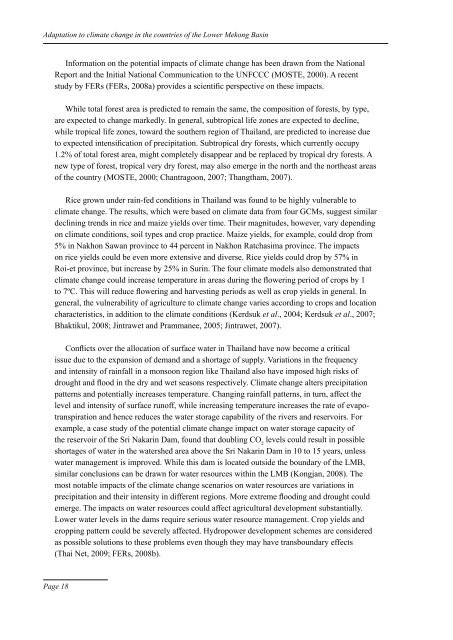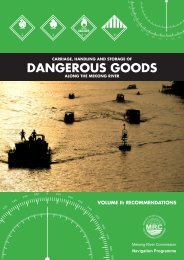Adaptation to climate change in the countries of - Mekong River ...
Adaptation to climate change in the countries of - Mekong River ...
Adaptation to climate change in the countries of - Mekong River ...
You also want an ePaper? Increase the reach of your titles
YUMPU automatically turns print PDFs into web optimized ePapers that Google loves.
<strong>Adaptation</strong> <strong>to</strong> <strong>climate</strong> <strong>change</strong> <strong>in</strong> <strong>the</strong> <strong>countries</strong> <strong>of</strong> <strong>the</strong> Lower <strong>Mekong</strong> Bas<strong>in</strong><br />
Information on <strong>the</strong> potential impacts <strong>of</strong> <strong>climate</strong> <strong>change</strong> has been drawn from <strong>the</strong> National<br />
Report and <strong>the</strong> Initial National Communication <strong>to</strong> <strong>the</strong> UNFCCC (MOSTE, 2000). A recent<br />
study by FERs (FERs, 2008a) provides a scientific perspective on <strong>the</strong>se impacts.<br />
While <strong>to</strong>tal forest area is predicted <strong>to</strong> rema<strong>in</strong> <strong>the</strong> same, <strong>the</strong> composition <strong>of</strong> forests, by type,<br />
are expected <strong>to</strong> <strong>change</strong> markedly. In general, subtropical life zones are expected <strong>to</strong> decl<strong>in</strong>e,<br />
while tropical life zones, <strong>to</strong>ward <strong>the</strong> sou<strong>the</strong>rn region <strong>of</strong> Thailand, are predicted <strong>to</strong> <strong>in</strong>crease due<br />
<strong>to</strong> expected <strong>in</strong>tensification <strong>of</strong> precipitation. Subtropical dry forests, which currently occupy<br />
1.2% <strong>of</strong> <strong>to</strong>tal forest area, might completely disappear and be replaced by tropical dry forests. A<br />
new type <strong>of</strong> forest, tropical very dry forest, may also emerge <strong>in</strong> <strong>the</strong> north and <strong>the</strong> nor<strong>the</strong>ast areas<br />
<strong>of</strong> <strong>the</strong> country (MOSTE, 2000; Chantragoon, 2007; Thangtham, 2007).<br />
Rice grown under ra<strong>in</strong>-fed conditions <strong>in</strong> Thailand was found <strong>to</strong> be highly vulnerable <strong>to</strong><br />
<strong>climate</strong> <strong>change</strong>. The results, which were based on <strong>climate</strong> data from four GCMs, suggest similar<br />
decl<strong>in</strong><strong>in</strong>g trends <strong>in</strong> rice and maize yields over time. Their magnitudes, however, vary depend<strong>in</strong>g<br />
on <strong>climate</strong> conditions, soil types and crop practice. Maize yields, for example, could drop from<br />
5% <strong>in</strong> Nakhon Sawan prov<strong>in</strong>ce <strong>to</strong> 44 percent <strong>in</strong> Nakhon Ratchasima prov<strong>in</strong>ce. The impacts<br />
on rice yields could be even more extensive and diverse. Rice yields could drop by 57% <strong>in</strong><br />
Roi-et prov<strong>in</strong>ce, but <strong>in</strong>crease by 25% <strong>in</strong> Sur<strong>in</strong>. The four <strong>climate</strong> models also demonstrated that<br />
<strong>climate</strong> <strong>change</strong> could <strong>in</strong>crease temperature <strong>in</strong> areas dur<strong>in</strong>g <strong>the</strong> flower<strong>in</strong>g period <strong>of</strong> crops by 1<br />
<strong>to</strong> 7ºC. This will reduce flower<strong>in</strong>g and harvest<strong>in</strong>g periods as well as crop yields <strong>in</strong> general. In<br />
general, <strong>the</strong> vulnerability <strong>of</strong> agriculture <strong>to</strong> <strong>climate</strong> <strong>change</strong> varies accord<strong>in</strong>g <strong>to</strong> crops and location<br />
characteristics, <strong>in</strong> addition <strong>to</strong> <strong>the</strong> <strong>climate</strong> conditions (Kerdsuk et al., 2004; Kerdsuk et al., 2007;<br />
Bhaktikul, 2008; J<strong>in</strong>trawet and Prammanee, 2005; J<strong>in</strong>trawet, 2007).<br />
Conflicts over <strong>the</strong> allocation <strong>of</strong> surface water <strong>in</strong> Thailand have now become a critical<br />
issue due <strong>to</strong> <strong>the</strong> expansion <strong>of</strong> demand and a shortage <strong>of</strong> supply. Variations <strong>in</strong> <strong>the</strong> frequency<br />
and <strong>in</strong>tensity <strong>of</strong> ra<strong>in</strong>fall <strong>in</strong> a monsoon region like Thailand also have imposed high risks <strong>of</strong><br />
drought and flood <strong>in</strong> <strong>the</strong> dry and wet seasons respectively. Climate <strong>change</strong> alters precipitation<br />
patterns and potentially <strong>in</strong>creases temperature. Chang<strong>in</strong>g ra<strong>in</strong>fall patterns, <strong>in</strong> turn, affect <strong>the</strong><br />
level and <strong>in</strong>tensity <strong>of</strong> surface run<strong>of</strong>f, while <strong>in</strong>creas<strong>in</strong>g temperature <strong>in</strong>creases <strong>the</strong> rate <strong>of</strong> evapotranspiration<br />
and hence reduces <strong>the</strong> water s<strong>to</strong>rage capability <strong>of</strong> <strong>the</strong> rivers and reservoirs. For<br />
example, a case study <strong>of</strong> <strong>the</strong> potential <strong>climate</strong> <strong>change</strong> impact on water s<strong>to</strong>rage capacity <strong>of</strong><br />
<strong>the</strong> reservoir <strong>of</strong> <strong>the</strong> Sri Nakar<strong>in</strong> Dam, found that doubl<strong>in</strong>g CO 2 levels could result <strong>in</strong> possible<br />
shortages <strong>of</strong> water <strong>in</strong> <strong>the</strong> watershed area above <strong>the</strong> Sri Nakar<strong>in</strong> Dam <strong>in</strong> 10 <strong>to</strong> 15 years, unless<br />
water management is improved. While this dam is located outside <strong>the</strong> boundary <strong>of</strong> <strong>the</strong> LMB,<br />
similar conclusions can be drawn for water resources with<strong>in</strong> <strong>the</strong> LMB (Kongjan, 2008). The<br />
most notable impacts <strong>of</strong> <strong>the</strong> <strong>climate</strong> <strong>change</strong> scenarios on water resources are variations <strong>in</strong><br />
precipitation and <strong>the</strong>ir <strong>in</strong>tensity <strong>in</strong> different regions. More extreme flood<strong>in</strong>g and drought could<br />
emerge. The impacts on water resources could affect agricultural development substantially.<br />
Lower water levels <strong>in</strong> <strong>the</strong> dams require serious water resource management. Crop yields and<br />
cropp<strong>in</strong>g pattern could be severely affected. Hydropower development schemes are considered<br />
as possible solutions <strong>to</strong> <strong>the</strong>se problems even though <strong>the</strong>y may have transboundary effects<br />
(Thai Net, 2009; FERs, 2008b).<br />
Page 18













